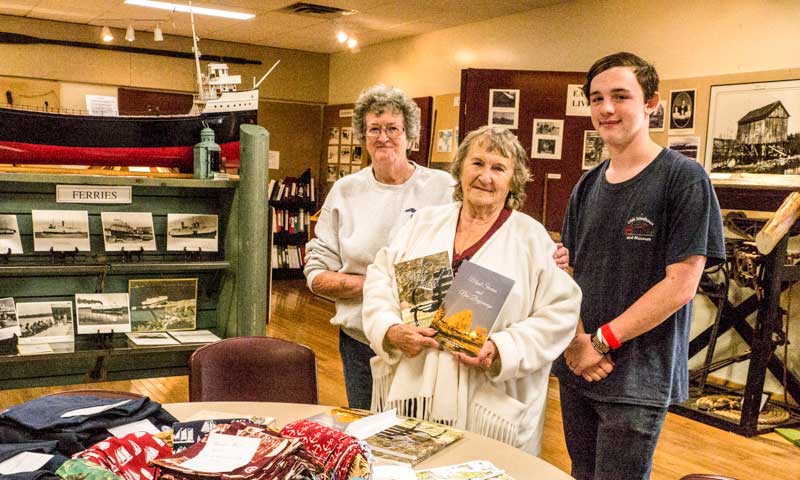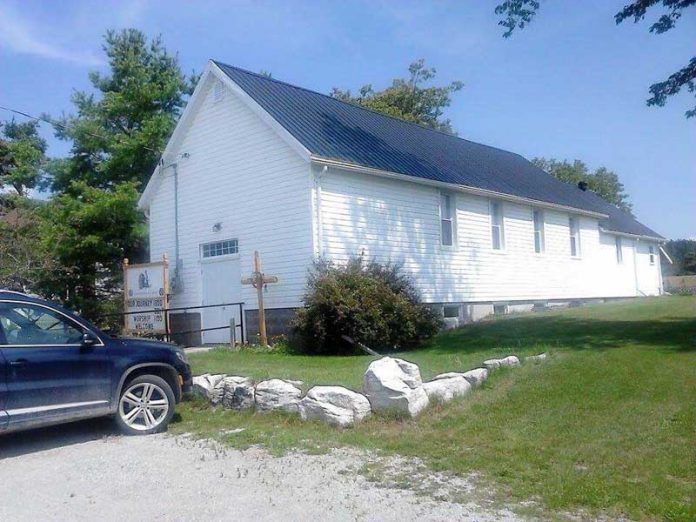TEHKUMMAH—With the ferry the focus, passengers coming to and leaving Manitoulin Island often drive or cycle right through the village of South Baymouth to points beyond, blithely unaware of the pastoral paradise that is the Township of Tehkummah. Oh, there are lodges and camps, campsites, trailer parks, tipis, resorts and bed and breakfasts, restaurants from all day-breakfast to fish and chips, fine dining and sunset dinner cruises, shops and art galleries galore and countless natural attractions from fishing to dark sky astronomy and horseback riding. But what we’re after this trip is a peek behind the scenes into the countryside of Manitoulin’s most southerly township, a quiet, scenic outpost on the east side of the Island.
In South Baymouth—a great starting point—on this summer day, the grounds of the Little Schoolhouse Museum host the Tehkummah Fire Department’s (TFD) annual barbecue, yard and bake sale to raise funds for equipment to keep the 25 volunteer firefighters (including 15 first aid responders), three trucks, an ambulance and two water pumpers operating at peak efficiency. Community folks and visitors browse the bargains while munching offerings from the grill and the bake table, pausing only to watch the majestic entry of the Chi-Cheemaun into port.
In the Museum, among the photos of early settlers, mills and the fishing industry, are displays of farming tools, a hundred-year-old ‘Log Cabin’ quilt, the community’s first telephone switchboard, and artifacts of WWI and WWII donated by local veterans’ families. The adjacent ‘little schoolhouse’ was built first as a church in 1891 before being converted to a school in 1898; the authentically furnished classroom seems as though it was in use just yesterday, blackboards cleaned and woodstove ready for a new school day.
Local author Patricia Hall (better known as Pat around these parts) is here with her two volumes of poetry, ‘A Fragile Thread’ (2013) and ‘Mind Storms and New Beginnings’ (2016), chatting with the curator of the Little Schoolhouse Museum, Loretta Mucha, and summer intern Phillip DeBruin; both Ms Hall and Ms. Mucha attended the school next door. Pat Hall has lived in the little nearby village of Tehkummah since 1947 when her family (her dad was born on Manitoulin) moved here from BC. She has been the Tehkummah correspondent for this newspaper “for about 35 years,” hand-writing her widely-read ‘Tehkummah Talk and Times’ weekly column, chatty anecdotes of animal sightings, drives around the township and of euchre games, lunches and concerts at the Community Hall. Her mom (who will be 101 years old in November) features in daily card games and meals out at favorite local haunts, as do locals and their comings and goings, their visitors, their joys and trials. “I’ve met so many people through my column,” says the lifelong writer. “Readers contact me all the time. When I was ill last year, I received 340 get-well cards!”
We decide to take in some of Pat Hall’s beloved home turf of Tehkummah on this iffy-weather sort of day that suddenly has become Manitoulin-summer-perfect. Sailing past South Baymouth’s plentiful offerings (saving those for another day), we cruise a little way up Highway 6 to Lakeshore Road. “Here,” says Ms. Hall, “are my Secret Gardens.” All along this road is a profusion of pink and white sweet pea flowers everywhere, climbing up grasses and trees and clinging to rocks and shrubs, perfuming the air with an indescribable sweet scent. “A Mr. Jackson had property near here with a beautiful garden where he planted sweet peas, so many they eventually overran the place and have become wild,” marvels Pat as we breathe in this legacy of sensory delights.
Concession roads may seem a bit of a maze to the visitor in Tehkummah, its gently hilly terrain, forest-lined bends and lazy curves a far cry from grid-style road layouts. In any case, it’s far preferable to ditch the GPS here and just follow all your senses around, like Pat Hall, appreciating the spectacular flora, fauna, and undulating views along the way.
The village of Tehkummah proper is home to the Fire Department, Community Hall (also known as the Seniors’ Hall), Municipal Hall, Library and Post Office. The much-loved R.A. Ward’s Store has been here since 1922, the interior looking exactly as it did then, supplying dry goods, gas and groceries as the community’s general store for almost a century, still run by the founder’s descendants.
Tehkummah Township is traversed by the Manitou River and the Blue Jay Creek, both successful rehabilitation projects of the Manitoulin Streams Improvement Association (www.manitoulinstreams.com), restoring these critical resources and their fish populations. The meandering paths of the water, babbling brooks in some spots and still pools in others, create the most bucolic vistas imaginable.
We’ve come to Michael’s Bay Road, off Government Road, where Pat Hall used to come as a child to pick wild strawberries and play by the falls beside the old ‘ghost town’ site of Michael’s Bay. Here, in 1867, on the site of a former Odawa settlement that dates to the 15th century, there was a prolific mill that cut and shipped millions of feet of pine, squared timbers and lath. A lighthouse was constructed in 1870 and a town plan laid out in 1879 for the population that would grow to several hundred souls by the mid-1880s.
The whole town burned in 1914, razing the mill and the homes and businesses to the ground. All that is left today of this former boomtown is a large expanse of flat field next to the falls where the mill was, now almost totally hidden by large trees. Ms. Hall points to wild asparagus that pops up every few feet. While this is an overgrown, unremarkable piece of land, there is an undefinable feeling to this place, of those who came before, a sense of the excitement of the lumber boom, the bust years that followed and of the ultimate tragic fire.
In a complicated series of events involving foreign investment and divestment, ably documented over the years by this newspaper, the Michael’s Bay Historical Society (MBHS) persists in its mandate “to preserve the history and artifacts for all citizens and visitors to enjoy and to educate others about Manitoulin’s first permanent settlement. The goal,” reads an entry on Wikipedia (MBHS will soon have a website), “is to protect the town site, which includes several cemeteries, from commercial or residential development.” Efforts by the Township of Tehkummah and the Michael’s Bay Historical Society to acquire the town site land are ongoing—it is now under the auspices of the Federal Government and outstanding Anishinaabe land claims must be settled.
For now, the old ‘ghost town’ site is closed to public access; the Municipal Park and boat launch on the left down Michael’s Bay Road give an idea of the expanse of the bay. It is possible, however, to visit one of the five cemeteries in Michael’s Bay that have been identified by the MBHS. A Methodist burial ground is signed on the right on Michael’s Bay Road; in the leafy glade small white crosses blooming in the dense ground cover mark the 43 graves that were found here. The mystery of Michael’s Bay is experienced viscerally, deep in the heart of Tehkummah, a moving remembrance of the past that merits consideration in the present to safeguard its future.
Patricia Hall’s books are available at the Rock & Rail (Mindemoya), Ward’s Store (Tehkummah) and at the Huron Lodge motel and the Little Schoolhouse Museum (South Baymouth).
The Little Schoolhouse Museum is open daily, 9:30 am to 4:30 pm, from May to October. Telephone 705-859-3663. ‘Michael’s Bay: The Rise and Fall of Manitoulin’s Forgotten Town’ by Derek Russell is available here, as are original survey maps of the town.
The Michael’s Bay Historical Society meetings on the second Thursday of each month are open to the public.




